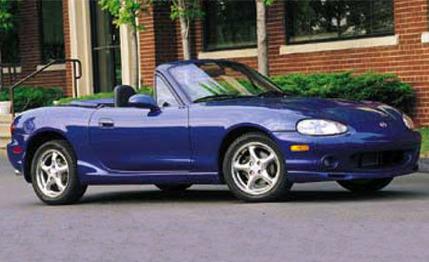
 Short Take Road Test
Short Take Road Test
Whoever said that there's nothing so rare as a day in June would have been inspired to greater heights of rapture had the day been spent in a Miata with the top down. What could be better? The warm sun on your dome, a light breeze on your brow, azaleas blooming alongside a meandering road, spring in the air.
In the Miata, you can poke along at 35 or 40 mph and absorb the atmosphere or pick up the pace and bend the roadster hard through the turns till the tires complain. Whichever you prefer, the Miata doesn't filter out any of the essences that make this kind of driving so much fun: It's agile but easy to drive. It's quick but not frighteningly fast. Its ride is firm but not so firm as to rearrange one's internal organs. In our preview test of this second-generation Miata (C/D, March 1998), we summed up these sports-car attributes in a phrase- "essential zest"-and went on to say that "the Miata captures it better than anything else on the road."
That was true of the off-the-shelf Miata, and it remains true for the 10th- anniversary edition of the MX-5. Auto-makers tend toward decorative excess with these commemorative models-the current 30th-anniversary Pontiac Firebird Trans-Am model being a notably garish example-but Mazda chose a subtle approach. Its birthday model is distinguished by a low-amp electric-azure paint job (Sapphire Blue Mica, Mazda calls it), which is eye-catching but not blinding, a silver-dollar-size badge on the left front fender, and high-gloss, five-spoke alloy wheels. Inside, there are blue synthetic-suede seat inserts that counterpoint black leather, the floor mats sport a 10th-anniversary-edition logo, and there are such adornments as delicate chrome rings around the tach and speedometer and "carbon-fiber-look" trim on the center console. Standard equipment includes the usual power convenience stuff and a Bose audio system. The entire package is tastefully executed and, at $27,325, adds almost $2000 to the price of a similarly equipped, noncommemorative Miata. Oh, yes, buyers also get a "gift set" with a scale model of the car, a special key ring, and his-and-hers Seiko watches.
Aside from the cosmetics and other goodies, this Miata also has a Torsen limited-slip differential, a sport-tuned suspension with Bilstein shocks, a front strut-tower brace for increased stiffness, and a six-speed manual transmission, which requires some explanation.
Aren't five gears enough? Well, for drivers who don't like shifting, laboring through a six-speed is a form of self-flagellation, But for traditionalists-the kind of people who prefer a sailboat and the work it requires to an effortless power boat-a six-speed adds a degree of personal control and wrings out another quantum of performance.
What's the difference between a five-and six-speed Miata trans? To put it simply, there's less of a jump between gears in the six-speed car. That makes it easier to keep the engine on full boil. Plus, even though the six-speed and five-speed cars have similar top-gear ratios, the six-speed car has a taller final drive, 3,91:1 vs. 4,30:1, which means the six-speed car hums at 3000 rpm in top gear at 60 mph-200 less rpm than in the base model.
Theoretically, the six-speed's closer gear spacing keeps the engine operating more nearly at peak power for quicker acceleration. In our track tests, this proved to be true. The five- and six-speed models are roughly equal off the line, but the six-speed gets to 60 mph in 7.6 seconds, 0.3 second quicker than the five-speed car. By 110 mph, the six-speed's 35.7-second time is 1.6 seconds less than the base car's.
On the road, these differences aren't all that apparent, but neither is the six-speed all that much more work. When the mood strikes, it doesn't take a lot of practice to settle into a pleasing rhythm of up- and down-shifting. The Miata's short-throw shifter requires little more than wrist action, and its heel-and-toe-friendly pedal placement helps maintain the illusion of being behind the wheel of one of those British sports cars of the '50s upon which the Miata is patterned.
As are all Miatas, this special edition is comfortable, good-looking, and eminently practical-for a two-seater. And its size, fuel economy, and nimble handling make it a useful daily driver. But that's just a bonus. It's on those days when you can flip the top back and head out to nowhere in particular that the Miata demonstrates its substantial worth.